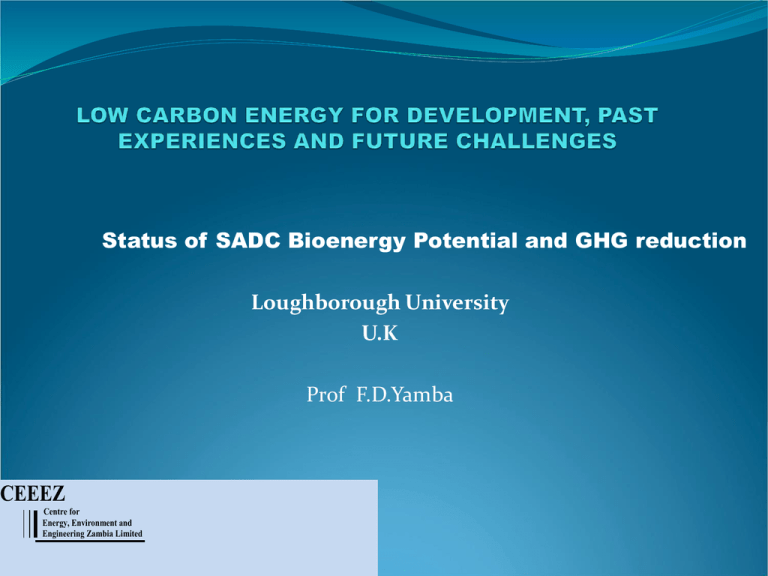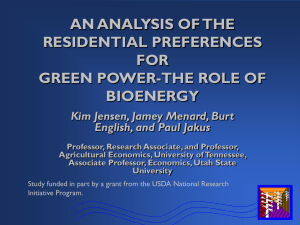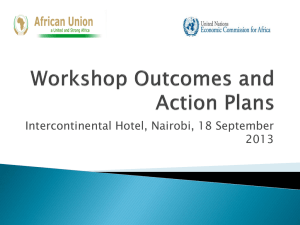Bioenergy prospects, potential and application to a low carbon
advertisement

Status of SADC Bioenergy Potential and GHG reduction Loughborough University U.K Prof F.D.Yamba CEEEZ Centre for Energy, Environment and Engineering Zambia Limited • Background • Ethanol Production Potential • Cogeneration Potential • Electricity Generation from Agric Crops Potential GHG Reduction Potential Background Energy crops Africa has a wide variety of crops suitable for bioenergy production due to its suitable climatic and soil conditions. The large areas of currently unutilised arable land places Africa in a strategic position as a continent with enormous potential for biofuels production. The most common bioenergy crop for biodiesel production in Sub-Saharan Africa is Jatropha, mainly because it is non edible, drought tolerant and suitable for cultivation in almost all countries. Other potential feedstocks include coconut, oil palm, sunflower, soy bean, animal fat, and castor oil. The main resources for bioethanol in Africa on one hand, include sugar cane, sweet sorghum, sorghum (grain), cassava, maize for first generation feedstock , and Background Cellulosic energy crops such as grasses, miscanthus, short rotation shrubs, straw and bamboo as second generation feedstock for both bioethanol and biodiesel Biodiesel from cellulosic biomass can be produced through a number of processes which include, Pyrolysis, gasification, Bioethanol from cellulosic biomass is produced through hydrolysis using special enzymes to convert cellulose to sugars which is then fermented Sugarcane The sugar cane plant is one of the world’s most cost effective and diversified renewable energy resource, offering many alternatives for production of food, feed, fibre, and energy. Sugar cane is widely grown in most SADC countries. The traditional focus in the SADC sugar industry has been the production of sugar only. Background However, changing international sugar market prices, adverse weather patterns, and recently EU sugar reforms have prompted the need for co-production of sugar, ethanol and electricity, simultaneously. A recent study has shown the potential to produce ethanol and electricity as co-products to sugar as summarised in the next two slides Ethanol Production Potentials Country From C-molasses (Million litres) % share of gasoline (energy basis) With Zero Sugar Exports % share of gasoline (volume basis) potential (Million litres) % share of gasoline (energy basis) Maximal Ethanol % share of gasoline (volume basis) (Million litres) % share of gasoline (energy basis) % share of gasoline (volume basis) Malawi 29.2 10.6 16.4 44.2 16.0 24.8 249.7 90.4 140.0 Mauritius 79.9 19.6 30.4 726.1 178.5 276.5 683.3 168.0 260.2 Mozambiq ue 28.2 14.1 21.9 163.1 81.8 126.6 241.2 120.9 187.2 316.5 1.1 1.7 2133.9 7.4 11.5 2707.6 9.4 14.6 Swaziland 61.4 23.4 36.2 564.6 214.9 332.8 525.7 200.1 309.9 Zambia 27.7 5.2 8.1 160.0 30.2 46.8 236.6 44.7 69.2 Zimbabwe 63.0 5.1 7.9 390.5 31.8 49.3 538.9 43.9 68.0 605.8 1.9 3.0 4182.4 13.2 20.5 5183.0 16.4 25.4 South Africa Total BIOENERGY Co-generation Potential • Two main strategies for selling surplus electricity from a sugar factory are possible. • The first option can be to sell to local off-grid customers, such as local industries or rural electricity cooperatives, thereby providing electrical services without the costs that accompany grid connections. • The second option is to sell surplus electricity to established utilities or distributors, as an independent power producer (IPP). BIOENERGY co-generation Potential BIOENERGY Co-generation Potential • This requires appropriate national policies that allow IPPs to generate and supply the public network. • Cogeneration potentials were determined for selected countries based on sugar factory data, and by assuming constant growth scenarios. • Through the CEST route, there is currently a technical potential of 10.6 TWh of electricity from this renewable energy resource, which is readily available as part of the SADC sugar industry. BIOENERGY co-generation Potential BIOENERGY co-generation Potential Combined Cycle with Integrated Atmospheric Gasifier Electricity generation from agriculture crops Agriculture crop wastes, most of which go to waste after harvest offer a good potential for possible electricity production, in particular in rural areas of SADC. As part of this assignment, a detailed analysis was undertaken to assess technical electricity production potential through use of agriculture wastes from major agriculture crops (which have feasible wastes for use) grown in SADC to include; wheat, sugarcane, sorghum, soya beans, seed cotton, and maize. Electricity produced through combustion of agriculture wastes and steam produced expanding on steam turbines and steam reciprocating engines was determined through knowledge of volume of production of the major crops, harvest residue and recoverability ratios, and energy content. BIOENERGY Agriculture Wastes Agriculture crop wastes, most of which go to waste after harvest, offer a good potential for possible electricity production, in particular rural areas of SADC. BIOENERGY AGRICULTURE WASTES BIOENERGY Agriculture Wastes • A possible technical potential of 11,528 TWh can be realized from this source. • The technical potential is based on the assumption that all the wastes remaining after recoverability is taken into account. BIOENERGY Agriculture Wastes • Below is the technical electricity production potential by country. The highest electricity production potential is coming from South Africa followed by Swaziland, Mauritius, and Zimbabwe. GHG Reduction Potential If the scenarios for electricity production are implemented, GHG mitigation potential from cogeneration through the CEST route is 10.5 million CO2 equiv and from electricity generation from agriculture crops is 11.5 million CO2 equiv . This combined potential represents 7% of total GHG emissions for the baseline scenario for the year 2020. Conclusions It is clear that bioenergy for both biofuel and electricity production can contribute moderately to GHG reduction for the SADC region: However, for this to happen requires innovative policies to include fiscal incentives such as Corporate Tax Incentives and Grant Programs. Leasing Programs and Loan Programs Performance-Based Incentives such as feed in tariff Innovative financing mechanism Thank you so much









